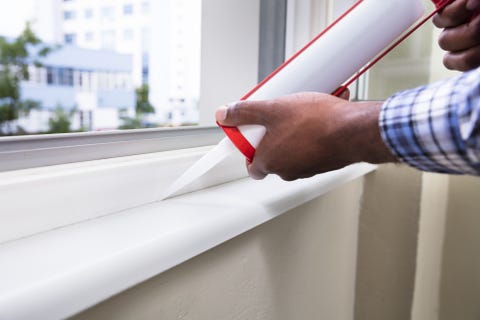Best Way to Track Down Drafts in House
If you lot turn up the thermostat and don't experience the heat, there'south a problem. Old windows, worn doors, and poorly installed outlet covers are basically an open invitation for the frigid winter air to make its fashion indoors. To avoid feeling the draft — and cutting down on your heating bill — follow these tips from the Proficient Housekeeping Institute.
Pay Attention to These Fundamental Areas
Before yous go effectually looking for leaks and drafts, it helps to know where to kickoff. Keep an centre out for these common problem areas that oft let cold air in.
- Electrical outlets
- Switch plates
- Door and window frames
- Baseboards
- Fireplace dampers
- Cranium hatches
- Wall- or window-mounted air conditioners
- Cable Goggle box and phone lines
- Vents and fans
How to Detect Leaks
Switch on a flashlight.
At night, shine a flashlight, like the Maglite Mini PRO LED Flashlight, on door and window frames. If the person on the other side sees light, you may have a leak.
Take hold of a dollar bill.
If you think doors are to arraign, slip a dollar bill (or standard piece of paper) under the door. If y'all tin can pull the dollar beak out without it dragging, then you accept a significant air leak.
Light some incense.
Turn off the furnace and water heater and turn on exhaust fans. Hold a lit incense stick past windows, outlets, doors, and whatever other suspected areas. If smoke blows sideways, yous likely have a leak.
Use a thermal leak detector.
Invest in a thermal leak detector, like the Black & Decker TLD100, to read surface temperatures of walls, doors, floorboards, and more. If the reading is a lot colder than the air, at that place's a leak.
How to Get Rid of Drafts
For cracks less than 1/iv inch, utilize caulk.
To fill cracks near windows and doors, use a long-lasting caulk that's fabricated for outdoor use. GE Silicone 2+, a Good Housekeeping Plant favorite, is 100% weatherproof, sun-proof, and freeze-proof (a.k.a. information technology's basically indestructible). In general, look for caulks made with mold-free engineering that adhere to common surfaces.
For cracks between i/4 inch and iii inches, utilize spray foam.
Avoid messy foam drips by finding a spray foam that comes with a straw, like Keen STUFF Insulating Foam Sealant. This quick-action foam deflects water and is tacky to touch in just eight minutes. Dissimilar caulk, spray foam can be more than hard to use so we recommend dispensing it onto newspaper before tackling trouble areas. To quicken the curing process — the time it takes to settle — mist the area with water before and subsequently spraying.
For doors, use a draft stopper.
Draft stoppers, like this all-time-seller on Amazon, prevent cold air from sneaking in nether doors. It may non exist as discreet as caulk or sealant, merely it gets the job done. You can choose from weighted textile versions that stay on the floor or plastic typhoon guards that fit effectually the door itself.
For bigger problems, fix your insulation.
If the insulation in your attic doesn't achieve the top of the floor joists, there's non plenty to trap heat. Visit a domicile comeback store for DIY attic insulation or rent someone to go the job done.
This content is created and maintained by a third party, and imported onto this page to help users provide their e-mail addresses. You may be able to find more data about this and similar content at piano.io
sommerfieldhappely.blogspot.com
Source: https://www.goodhousekeeping.com/home/renovation/advice/a26937/draft-proof-home/





0 Response to "Best Way to Track Down Drafts in House"
Post a Comment